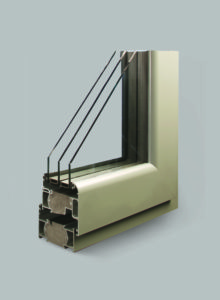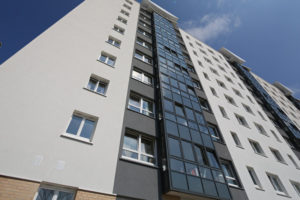
Andrew Cooper, National Specification Manager from Senior Architectural Systems explains why new developments in window systems can help meet energy efficiency targets.
All properties lose heat through windows and doors but the amount of energy that is lost can vary significantly depending on the type of system used. Replacing older, single-glazed windows with double or even triple- glazing is an obvious starting point but choosing a system that contains a thermal barrier is where the real energy savings can be made.
 The use of an effective insulating material between the inner and outer frame is key to avoiding thermal bridging which, at its simplest, is a weak spot in insulation of a building that allows heat to escape from the inside out and for cold air to pass back into the room.
The use of an effective insulating material between the inner and outer frame is key to avoiding thermal bridging which, at its simplest, is a weak spot in insulation of a building that allows heat to escape from the inside out and for cold air to pass back into the room.
Traditionally the material of choice for thermal barriers has been the low thermal conductor polyamide but new product innovations, such as Senior’s new PURe window system, have been developed to offer even greater energy efficiency. The new PURe system, for example, is the first on the UK market to incorporate a thermal barrier made from expanded polyurethane foam, a material that is more commonly used in insulation and cladding products and that has long been recognised for its excellent thermal properties.
U values
When it comes to U-value ratings, less is more and the lower the figure, the more heat is retained. The U-value of a window system is dependent on a number of factors including the frame material, the type of glazing and the use of a warm edge spacer bar, which provides the space and insulation between the two or three panes of glass.
Part L of the Building Regulations, BREEAM, Code for Sustainable Homes and Passivhaus standard can all have requirements for the whole window U-values of windows and doors but as such legislation and guidelines can and often do change, it is well worth ‘future-proofing’ housing stock by specifying a window system that not only meets current targets but exceeds them.
By reducing carbon calculations through the specification of low U-value windows, the project team potentially have the flexibility of looking at making monetary savings in the overall build cost by reducing the need for other, often more expensive, sustainable features such as photovoltaic roof panels or under floor insulation.
Money saving
 As well as saving energy, saving money is understandably a key consideration and there is no need to pay a premium for window systems that benefit from high performance thermal barriers. Indeed, Senior’s PURe range is priced as competitively as any other aluminium window system on the market and requires no special tooling.
As well as saving energy, saving money is understandably a key consideration and there is no need to pay a premium for window systems that benefit from high performance thermal barriers. Indeed, Senior’s PURe range is priced as competitively as any other aluminium window system on the market and requires no special tooling.
However cost-effectiveness is an ongoing requirement so looking at the maintenance and lifecycle of a product is another key requirement. In terms of a long-term investment, aluminium is tough to beat and the use of an aluminium window system is ideally suited for both new build schemes and the refurbishment of older housing stock. The thermal barrier in products such as Senior’s PURe system can also be reused as fillers for other products, with no requirement for landfill.
As well as careful specification, care must also be given to the positioning of doors and windows within a property. During the installation process, details such as ensuring the continuity of insulation by wrapping it around the frame and paying attention to the interfaces with the walls to achieve the maximum levels of airtightness are essential if the energy efficient system is to perform to its full potential.
BIM modelling
The use of Building Information Modelling (BIM) can reduce risk. By revolutionising the current linear workflow, the BIM process allows numerous people to share the information incorporated in the 3D graphical representation of the model in a way that enables changes to be seen almost immediately by everyone throughout the supply chain.
By using BIM, the installation process can be dramatically improved as schedules are automatically created with the BIM model also able to provide detailed information on the size, finish and positioning of a window such as if it is top or bottom hung.
Acoustic performance
As vital as it is the windows keep the heat in, it’s also important that they keep the noise out and acoustic performance is, like thermal efficiency, a key requirement. Fortunately the development of new products, which offer exceptional thermal and acoustic performance, eliminates the need for compromise.
Every house needs windows, and all windows need be as energy- efficient as possible to make a comfortable and pleasant home that is affordable to heat. Fortunately the new generation of fenestration systems that offer greater thermal performance is providing specifiers with a new window of opportunity to meet these targets head on.
